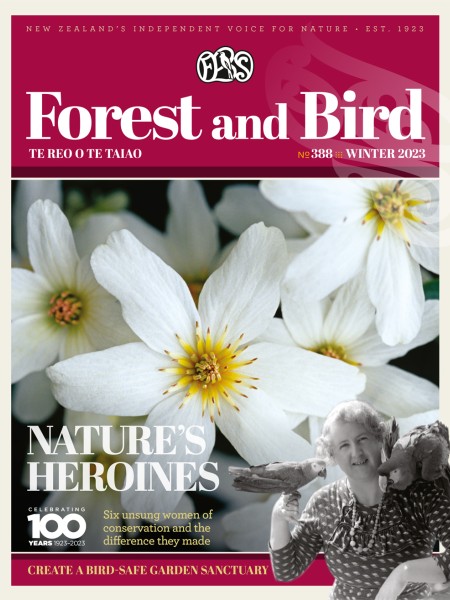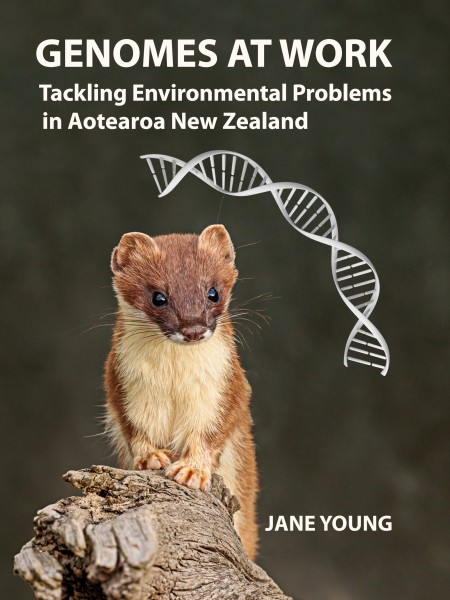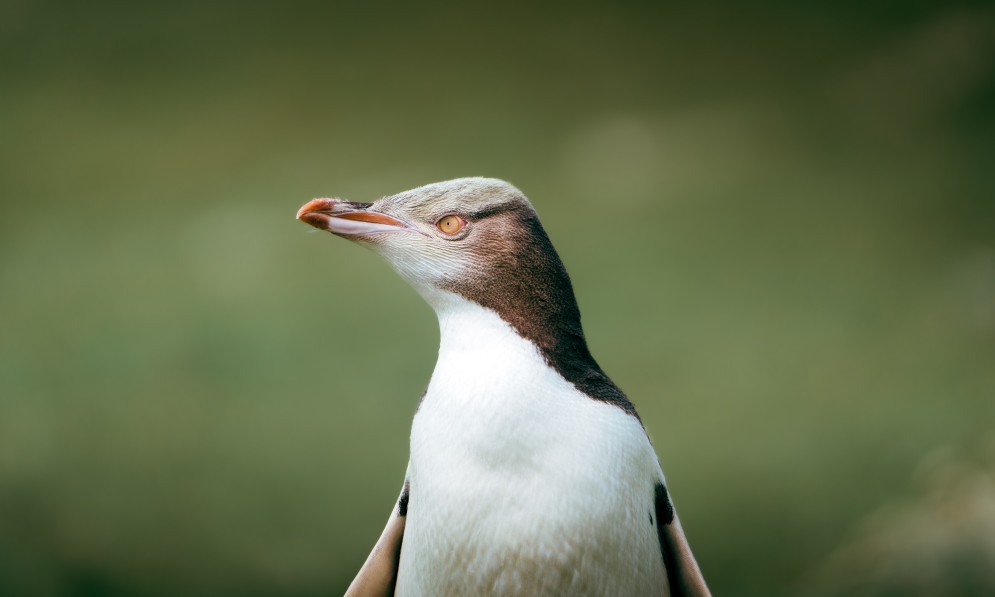DNA data can give us tools to aid the recovery of yellow-eyed penguins
on the Aotearoa mainland, but only a change in human behaviour can give
them a fighting chance of avoiding extinction, as Jane Young explains.
Forest & Bird magazine
A version of this story was first published in the Winter 2023 issue of Forest & Bird magazine.

Hoiho are on the brink. During the last decade, despite increasingly desperate intervention measures, the number of mainland yellow-eyed penguins has plummeted by more than 70%, with no recovery in sight.
It’s possible, just possible, we can still avert a local extinction: Ban fishing in penguin foraging areas. Preserve and restore habitat. Protect penguins from disturbance by people, dogs and vehicles. And, most importantly, take action to reduce the long-term existential threat of climate disruption.
Genomic technologies also have a part to play in efforts to save hoiho. Genetic data provides vital information that conservation managers need in order to make wise decisions. And, more controversially, it might be possible to develop conservation techniques that involve direct manipulation of genetic material.
First, we can use genomics to better know a species – in this case, our iconic hoiho, proudly displayed on Aotearoa New Zealand’s $5 bill.
For a long time, we thought the yellow-eyed penguin Megadyptes antipodes was the only twig on its evolutionary branch. But, in 2009, researchers announced that ancient DNA analysis of fossil and archaeological bones in museum collections had led to a startling discovery.
There were actually two subspecies of M. antipodes – hoiho and the smaller Waitaha penguin. Then in 2015, researchers discovered a third “big diver” – Richdale’s penguin.
Humans arrived in Aotearoa sometime between 1250 and 1300CE, accompanied by kiore Pacific rats and kurī Polynesian dogs.
Within a few centuries, both Richdale’s penguin, which was restricted to the Chatham Islands, and the Waitaha penguin, found in the lower North Island and the South Island, had been driven to extinction.
Fossil and genetic evidence indicates that only hoiho survived, safe in its remote habitat in the Auckland and Campbell Islands.
Conservation genomics aims to understand how the information encoded in complete sets of DNA (genomes) of living organisms can provide molecular tools for assessing their biodiversity, taxonomy, population demography, disease resistance, adaptation, and evolutionary history.
Despite their close evolutionary relationship, the three Megadyptes subspecies never got to be kissing cousins. Rare hoiho vagrants occasionally turned up far outside their normal range but didn’t establish breeding colonies.
Shortly after the Waitaha penguin disappeared, however, the advent of the Little Ice Age made the mainland a more attractive destination for the cold adapted hoiho. Within 50 years, it had taken possession of the vacant ecological niche.
Unfortunately, the limited number of founding individuals could be an Achilles heel for hoiho due to the resulting lack of genetic diversity, especially in genes that contribute to tolerance of high temperatures.
As the penguins now face an increasing number of stressors, the resultant population crashes further squeeze the genetic bottleneck and reduce the reservoir of potentially helpful variation.
There’s little hope that sub-Antarctic populations will come to the rescue. Not only is it a very long swim between the islands and the mainland, but hoiho are philopatric, meaning that when the juveniles come back from their big OE they usually return to the place where they fledged.
Consequently, the southern and northern populations are genetically distinct from each other, and there’s very little gene flow between them.
Vet Lisa Argilla treats a sick penguin at Dunedin Wildlife Hospital in 2016. Image Yellow-Eyed Penguin Trust
Deadly pathogens and life-saving vaccines
Enormous efforts go into protecting the world’s most endangered penguin. Annual conferences bring together researchers and conservationists to share their war stories.
For a while, it appeared that the battle was being won, but since 2012 hoiho populations have been in free fall. Conference attendees have been heard to comment with dark humour that researchers will soon outnumber the penguins.
One of the main threats to hoiho, and one that will only increase as human-induced climate change really starts to bite, is the spread of a number of infectious diseases.
One of the worst of these is avian diphtheria. It’s a horrible disease in which the mouth becomes covered by bacterial plaques. Thick pus and painful ulcers prevent infected chicks from eating. Death from starvation or sepsis frequently results.
Avian diphtheria may have first appeared in hoiho in 1999, but the pathogen responsible wasn’t identified until 2021, when researchers announced that they had isolated strains of Corynebacterium from the mouths of infected chicks.
With the aid of genome sequencing and the recently developed technique described as “matrix-assisted laser desorption ionization – time of flight mass spectrometry” (MALDI-TOF MS for short), these strains were shown to belong to a previously unknown species. A diagnostic genetic tool was then developed for rapid and reliable identification.
Although the new species had multiple virulence genes, it turned out to be less pathogenic than its relations. It’s an opportunist, deadly to young penguin chicks because their immune systems are underdeveloped.
However, there is a ray of hope. One of the bacteria’s virulence genes codes for a protein that is very effective in triggering a host response to infection so may be useful when developing a vaccine.
Respiratory distress syndrome, an even more lethal condition, emerged in 2019. During the following season, more than 90% of the young chicks affected died within a few days, either on the nest or in Dunedin Wildlife Hospital, where they were taken for intensive treatment. On necroscopy, their lungs appeared dark pink to purple, full of haemorrhages and clots.
High-throughput sequencing technology showed the presence of a novel gyrovirus in 80% of the samples taken from infected birds. Gyroviruses are known to cause serious diseases in some bird species, so this new one is a possible culprit.
There are vaccines against strains that attack chickens, but developing a similar one for penguins is likely to be a long way down the track.

Hoiho standing on predator trap box. Image Jeremy Sanson
Intelligence gathering for pest control
Genomic technology has enormous potential for intelligence gathering in the campaign to eradicate the introduced predators threatening hoiho and other native species.
For instance, when a single stoat was trapped following a mustelid eradication programme on Rangitoto Island, DNA evidence showed it wasn’t a survivor of the original population but had made a marathon 3km swim from the mainland.
When dogs attack penguins, genetic profiling, which was originally developed for human forensics, could enable identification of an individual suspect. It can also indicate the species of predator involved. In January 2020, three hoiho chicks at Katiki Point, Otago, were killed by mustelids, possibly ferrets, and Moeraki-based Penguin Rescue staff made the difficult decision to take all the remaining hoiho chicks into protective custody.
The culprits – ferrets – were eventually caught but not until after a change in the trapping strategy. Ready access to affordable DNA testing might have determined much sooner whether ferrets rather than stoats were to blame and also whether the trapped individuals had been the ones that killed the chicks.
In recent years, environmental DNA (eDNA) testing has come to the fore. It can be used to sample soil, water, air, or even faeces, and test simultaneously for the presence of hundreds of different kinds of living organisms.
This big-picture technique doesn’t provide information about individual organisms and can’t yet tell us the sizes of the populations present, but scientists are working on it.
An Otago University lab is also developing a sampling technique along the lines of a RAT test –but testing for actual rats rather than for Covid.
Knowledge is key. Take mustelids. New Zealand scientists led a project that sequenced the 2.4 billion base pair stoat genome, which turned out to have about 20,000 protein-coding genes.
Stoats are closely related to ferrets, which are widely used in medical research, so knowledge gained from ferret studies can help make sense of the stoat genome.
Manaaki Whenua researchers are using genome-mining techniques to help them design toxins that will be more selective and more humane.
Pushing the boundaries: genetic editing
So far, so uncontroversial. Now we get to the tricky stuff. Could or should genetic modification, gene editing, or gene drives get in on the act?
Research relevant to New Zealand looks at how genomic technologies could reduce predator fertility. The problem is that because of the way inheritance works, any new edited gene introduced into a population is likely to be swamped by the standard version within a few generations.
But there’s a cunning plan. If you can cheat by making sure that only the mutant gene gets passed on to the next generation, then the transmission of the normal gene may quickly come to a shuddering halt. This is what gene drives are all about.

Genomes at Work: Tackling Environmental Problems in Aotearoa New Zealand by Jane Young.
Natural gene drive systems have been around for a very long time. For instance, there’s one found in a species of mosquito that causes most of the offspring to be male.
Human use of gene drives, however, is still in its barest infancy and comes with lots of questions that will need to be answered when weighing up the potential risks and benefits.
How can we slow down the evolution of resistance to gene drives? Could the gene drive escape and wipe out a non-target population? How can you stop a gene drive once you’ve let it loose? If you squelch the population of one species, what will be the effect on others in the ecosystem? And so on.
The aim isn’t always to exterminate unwelcome species. Take mosquitoes. Yes, they’re a pesky biting nuisance, but the main problem is that they carry diseases that impact both humans and wildlife. In the 2018/19 season, at least 29 hoiho died from avian malaria spread by mosquitos.
Overseas researchers are looking at the use of gene drives, not necessarily to eliminate mosquitoes, which are important parts of natural ecosystems, but to modify certain species so that they can no longer host the parasite that causes human malaria.
Perhaps one day New Zealand scientists will be able to piggyback on this research and reduce the ability of our native and introduced mosquito species to transmit avian malaria. But it won’t be simple. It won’t be quick. And it certainly won’t be cheap.
As hoiho stare down the barrel of extinction, genomics can give us tools to use in their conservation management. What technology can’t do is provide miracle solutions.
It can’t weigh up the moral and ethical factors that must be involved in decision-making. And, sadly, it can’t change the indifference of so many people.
Quite possibly, it’s too late to save hoiho. But it’s some comfort to know that thousands of New Zealanders believe it’s not too late to try.
Jane Young is a science educator, editor, and freelance writer with a number books under her belt, including Pet Genetics: How bulldogs got flat faces and Manx cats lost their tails. She co-chairs Forest & Bird’s South Otago Branch and escapes from the computer by working in the native plant nursery that she and her husband established in the Catlins. Jane would like to thank Nic Rawlence, Bruce McKinlay, and Rosalie Goldsworthy for reviewing this article.

